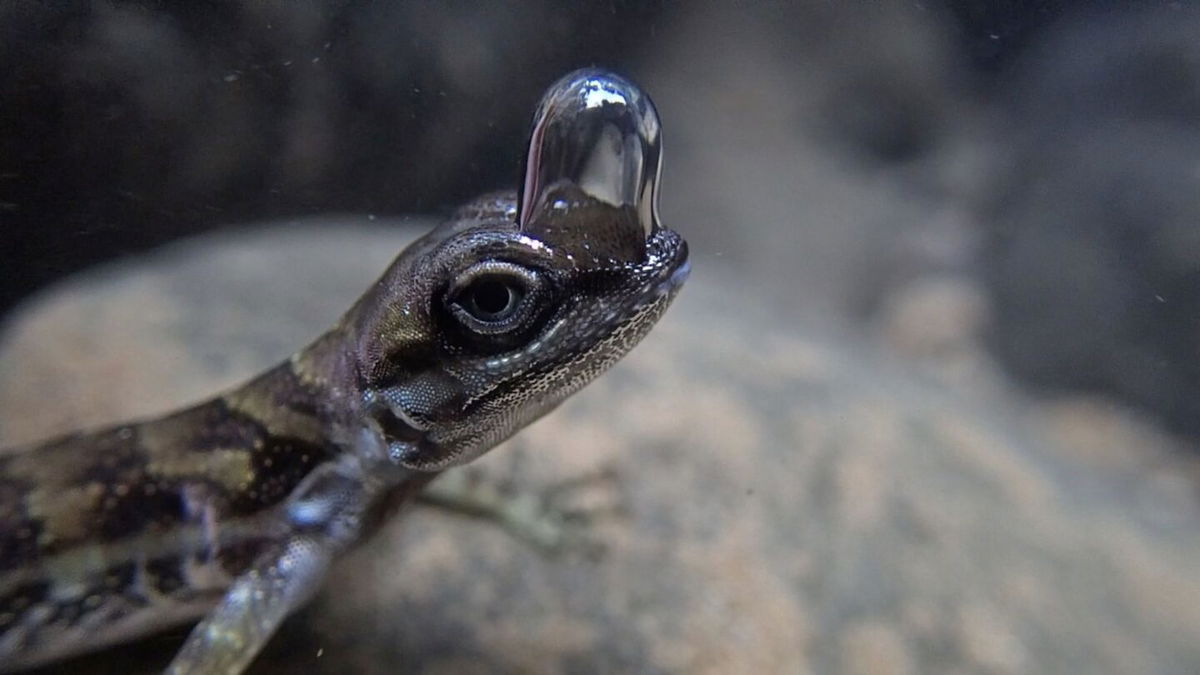Diving lizard’s built-in ‘scuba tank’ allows it to breathe underwater, scientists say

When submerged underwater
(CNN) — In a Costa Rican rainforest, a small, semiaquatic lizard called a diving anole leaps into a stream. Minutes pass, but the anole doesn’t surface for air, as these lizards typically do. Instead, the submerged lizard crouches on a river rock, a small air bubble atop its head expanding like a balloon and then shrinking. Like a scuba diver, the reptile is breathing a reservoir of stored oxygen.
Using this bubble helps anoles prolong their stay underwater, according to Dr. Lindsey Swierk, an assistant research professor of biological sciences at Binghamton University in New York. Footage that Swierk recently captured of submerged anoles shows prominent bubbles swelling and deflating on the reptiles’ heads. This technique could help anoles hide from predators on land, Swierk reported Tuesday in the journal Biology Letters.
Swierk has studied diving anoles for nearly a decade, teaming up in 2021 with other researchers to describe bubble-breathing behavior across multiple species of semiaquatic lizards in the Anolis genus.
“A lot of collaborations have emerged from some pretty basic questions — just a lot of us watching these videos, wondering how it happens, why it happens,” she told CNN.
For the new study, Swierk investigated the species Anolis aquaticus, which lives near forest streams in southwestern Costa Rica and western Panama. Swierk found that bubble formation directly affected how long an anole could stay submerged. During experiments, bubble-breathing anoles remained underwater for 3 ½ minutes on average. It was about 32% longer than anoles that were prevented — through the application of an emollient to parts of their heads — from forming air bubbles.
“They can lengthen their dives by using these breathing bubbles,” Swierk said.
Diving anoles aren’t fast runners and rely mostly on camouflage to hide from predators such as birds, snakes, mammals and other lizards. And when camouflage fails, waiting out a threat underwater is an effective survival strategy, Swierk said.
‘A fascinating behavior’
Trapping air in bubbles to breathe in water is practiced by some types of insects and arachnids, such as water beetles and diving bell spiders. So far, anoles are the only animals with backbones that are known to breathe using bubbles.
“This is such a fascinating behavior in lizards,” said Dr. Earyn McGee, a herpetologist specializing in lizards and coordinator of conservation engagement at the Los Angeles Zoo. “This kind of research will add to our understanding of how these lizards and potentially other animals evolved their underwater breathing techniques.”
To get a closer look at the anoles’ bubble-breathing method, Swierk collected A. aquaticus anoles at Costa Rica’s Las Cruces Biological Station. Their destination was a nearby “arena” — a clear plastic tank containing stream water and rocks. In one group of anoles, the researchers daubed the reptiles’ snouts and heads (avoiding the nostrils) with a thin layer of emollient to prevent air bubbles from adhering to the anoles’ heads. The scientists then submerged the anoles and filmed them in the arena until they surfaced.
In the unmoisturized control group, all anoles produced large bubbles that they repeatedly rebreathed, at a rate of about six per minute. Some anoles in the emollient-treated group produced bubbles, too, but they were much smaller and didn’t stick to the lizards’ skin, as rebreathed air bubbles did. In both groups, anoles performed a throat-pumping action called gular pumping, which many types of lizards use to supplement their lungs with oxygen.
For diving anoles, gular pumping may also play a part in circulating stored oxygen, affecting how long anoles can stay underwater. But in the experiments, moisturized anoles that couldn’t produce oxygen-filled bubbles surfaced 67 seconds sooner than those that used bubbles to breathe.
However, this scuba-like tactic comes with a downside.
“One of the costs of diving is that they get very chilly,” Swierk said. Mountain streams are usually cold, and as ectotherms, anoles regulate body temperature through their environment.
“They pay a temperature cost when they dive,” she said. Being too cold “could reduce their ability to run quickly, defend their territories against invaders, court mates, or digest their food.”
Another drawback may be that if a submerged lizard is still visible, a predator may simply wait for it to resurface, McGee said.
“The lizards can only be submerged for so long,” she said. “How does the lizard know when it’s safe to come out — or do they just exhaust all their air, then reemerge?”
The mechanism of anoles’ bubble breathing is something that Swierk is hoping to piece together through collaborations with multiple research groups. One part of the puzzle is whether the anoles’ head shapes or microscopic structures in their scales affect the volume of air filling their bubbles. Another unresolved question is how diving anoles store and circulate oxygen while underwater.
“To our knowledge right now, the oxygen that the lizard is using, it takes underwater with it,” Swierk said. That oxygen may be stored in its lungs, in other parts of the respiratory system or in air pockets adhering to its skin, which are then incorporated into the head bubble.
Oxygen may also diffuse into the bubble from the water, “but we don’t know that for sure,” Swierk added. “We’re still working on that.”
Mindy Weisberger is a science writer and media producer whose work has appeared in Live Science, Scientific American and How It Works magazine.
The-CNN-Wire
™ & © 2024 Cable News Network, Inc., a Warner Bros. Discovery Company. All rights reserved.